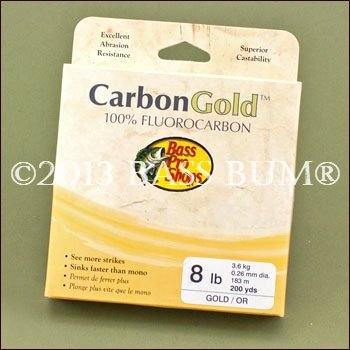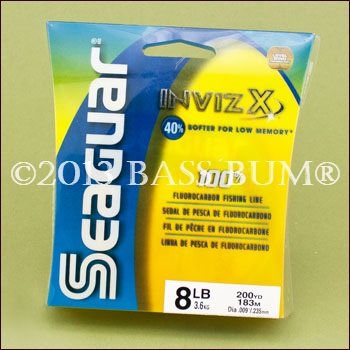Fluorocarbon Fishing Line - Why Use It, Instead Of Mono Or Braid?
Fluorocarbon Line Properties, Features and Benefits. Is This Stuff Really As Good As Everyone Says?
The technical and chemical aspects of fluorocarbon fishing line are what allegedly makes it such a good choice for so many applications. It is a "single strand" polymer. What's a polymer? It's a bit like mixing eggs, sugar, milk and cake mix, putting it in the oven and, poof, you have a chocolate cake.
 |
 |
Fluorocarbon line, however, is created by combining fluorine, hydrogen and carbon molecules. How do they do this? I have no idea! What I do know is that doing this creates a line that is dense and does not absorb water so it sinks and is abrasion resistant. These are important features in numerous situations.
It is also has the same refractive index as water. All the technical explanation about this feature aside (we don't really care about that do we?), what this means to you and me, at least according to the manufacturers, is that the bass can't see it. That we do care about!

Reality Check!
Fluorocarbon line is not really 100% invisible under water nor is it invisible to the bass, but it is less visible.
Fluorocarbon Hype Versus Reality
• Bass Can't See It. Or Do They Just Not See It As Well?
It's the invisibility under water of fluorocarbon fishing line. That is what you usually hear is its "flagship" quality. True, it is a great benefit if in fact it can't be seen by bass, especially in clear water situations. If we remove the "line profile" from our presentation do we not increase our odds of catching bass. This trait also leads many anglers to use heavier pound lines, perhaps 15-17lb in some situations where otherwise, with mono, they would normally use 12-14lb line. Therein lies the rub.
"Line profile" is more than just the "actual" visibility of the line. It is also the amount of water disturbance created as the line moves through he water. Remember, the bass has a "lateral line" that helps it "see" objects. without really seeing them. This leads me to wonder if line diameter is not just as important as actual line visibility. If you use larger diameter, higher pound line will this not offset the benefit of reduced visibility?
What about this? Fluorocarbon line is supposedly rendered virtually invisible due to it having the same light refractive index as water. But what about "background" against which the line is imposed? A dark background will present significant contrast to the "clear" line. Wouldn't this affect the lines visibility?
Hey, I'm just thinking out loud here. I'm just saying......
• It Is Abrasion Resistant, But Not Fracture Resistant!
Generally speaking fluorocarbon fishing line has a chemical composition that makes it quite dense and when combined with the extrusion process creates a hard finish. It also doesn't absorb water. What does this mean to you? It means you have a very abrasion resistant line which maintains its strength and works well even in heavy cover situations. Some bass anglers use it for flipping jigs.
Don't lose sight of the fact that each manufacturer has different "specs" for its lines so you will encounter marked differences between brands. Trial and error is your best chance for settling on a line that "works best in your hands". After all, how it works for you, with your rods and reels, should be the final deciding factor.
Fluorocarbon line will fracture if not fray as with monofilament. The hardness of the line makes it vulnerable to "cracking", however, and it is at these cracks that weak spots develop. These cracks can occur if a bass wraps your line around a rock, a dock pillar or any other object. Later, you may suffer a break-off at the point of the crack. So contrary to popular opinion that re-tying is not necessary with fluorocarbon line, you should do so after being wrapped around any object be it a dock support or rip-rap.
• They Say Fluorocarbon Doesn't Stretch. They Must Be Kidding!
The nature of the material from which fluorocarbon line is made is said to create a low stretch fishing line. We're told this translates into strong, sure hook sets, even at long distances.
Reality, fluorocarbon fishing lines all stretch from between 28-38%, a fact borne out in numerous lab tests. That's as great as, or even greater than, some monofilaments. In fact, the brands that have been developed to be the most limp and easiest to handle tend to be the most stretchy (is that a word?). Of course, the stiffer brands exhibit less stretch.
Just as with monofilaments, when a manufacturer emphasizes one feature in their fluorocarbon line there is often a trade-off of another. To enhance manageability they might have to accept greater stretch for example.
Another interesting fact is that fluorocarbon lines stretch and stay stretched, unlike monofilament. Mono's are "elastic", that is, once stretched, when the load is removed the line resumes its original form. But fluorocarbons stay stretched when the load is removed, they don't recover to their original form.
Perhaps this trait is what contributes to the claims that it produces great hook sets because it doesn't stretch. Once stretched, it does not recover its original shape. So after the original stretching, there is indeed virtually "no stretch" left.
• Does Fluorocarbon Fishing Line Sink?
Indeed it does. Fluorocarbon line is very dense, almost twice that of mono or braid by almost double. This means it will sink and do so at a much more rapid rate than either mono or braid. This trait makes it an excellent choice for any lure you need to get deep. Additionally, this density causes the line to break the water's surface tension and sink so it will not bow on the surface of the water as does mono. We all know that bows in the line reduce our ability to feel strikes deep or shallow.
• Knot Strength And Fluorocarbon Line
A very critical aspect of using fluorocarbon fishing line is knot tying. Any knot which causes the line to overlap itself where it isn't so intended will likely result in a crack developing. This is the cause for knot failure with fluorocarbon lines. A good comparison is the way a strand of wire is weakened when kinked. It's the same with fluorocarbon line.
What are the best knots for fluorocarbon? Ask twenty bass fishermen and you'll likely get twenty different answers. The critical consideration is to tie whatever knot you use properly, avoiding incorrect overlapping of the line. In other words, lubricate your line and hook eye well, pay attention to important knot details and tie your knots neat.
My knot of choice for fluorocarbon fishing line is the Palomar knot though many consider the Trilene knot as the best. I take particular care in tying it and make sure it is well wetted when cinched. I do not experience many problems with fluorocarbon line and Palomar knots.
• Baitcasters, Spinnning Reels And Fluorocarbon Fishing Line
Line memory, stiffness, twists, loops and springiness (yep, it's a word, I looked it up in Webster's) are facts of life with fluorocarbon lines. Consequently, while working without much problem on baitcasting reels, fluorocarbon line can make for a miserable day when you're using it on spinning reels. Open the bail and you may well have an out of control "Slinky" on your hands. I don't care what the manufacturer's say about how soft and manageable their particular fluorocarbon line is.
I do use Real Magic, made by Blakemore Sales, on my reels spooled with fluorocarbon line. While spooling line I run it through a towel soaked with this product and spray it on each spool prior to hitting the water. I really feel it helps "loosen" up the stiffness in fluorocarbon line. Nevertheless, when using fluorocarbon line on spinning reels it still gives me my share of heart burn.

My Humble Recommendations
When And Where I Use Fluorocarbon Fishing Line
I do in fact use fluorocarbon fishing line. My favorites are Berkley Vanish Transition (because of its visibilty above water) and Trilene 100% Professional Grade Fluorocarbon (great handling and knot strength). I occasionally use P-Line CX Premium and Floroclear, which are really "coated" copolymers (basically monofilament line coated with fluorocarbon) and not 100% fluorocarbon.
The following are some of my uses for fluorocarbon line:
- Clear water
- Leader, especially with Carolina rigs
- Drop shotting, 6-8lb test
- Jerkbaits, 10-12lb test
- Soft paddle tail swimbaits, 10-15lb test (not the big, hard body versions like in California)
- Wacky worming, 8-10lb test
The following are where I don't use fluorocarbon line:
- Spinnerbaits (the line sinks and if you want this lure close to the surface you'll use monofilament)
- Frogs
- Spooks and other hard body topwaters
- Buzzbaits
- Soft plastics
- Flipping and pitching
What I've provided here is information about fluorocarbon lines as I understand them based on my personal experiences and much research. If you speak to other bass anglers they'll have differing opinions no doubt. Hopefully, this information helps in contributing to you becoming an "informed" angler better able to make decisions about using fluorocarbon fishing line.
Return To Bass Fishing Tackle From Fluorocarbon Fishing Line
